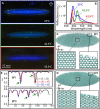Prolate and oblate chiral liquid crystal spheroids
- PMID: 32832603
- PMCID: PMC7439570
- DOI: 10.1126/sciadv.aba6728
Prolate and oblate chiral liquid crystal spheroids
Abstract
Liquid crystals are known to exhibit intriguing textures and color patterns, with applications in display and optical technologies. This work focuses on chiral materials and examines the palette of morphologies that arises when microdroplets are deformed into nonspherical shapes in a controllable manner. Specifically, geometrical confinement and mechanical strain are used to manipulate orientational order, phase transitions, and topological defects that arise in chiral liquid crystal droplets. Inspired by processes encountered in nature, where insects and animals often rely on strain and temperature to alter the optical appearance of dispersed liquid crystalline elements, chiral droplets are dispersed in polymer films and deformation induced by uniaxial or biaxial stretching. Our measurements are interpreted by resorting to simulations of the corresponding systems, thereby providing an in-depth understanding of the morphologies that arise in these materials. The reported structures and assemblies offer potential for applications in smart coatings, smart fabrics, and wearable sensors.
Copyright © 2020 The Authors, some rights reserved; exclusive licensee American Association for the Advancement of Science. No claim to original U.S. Government Works. Distributed under a Creative Commons Attribution NonCommercial License 4.0 (CC BY-NC).
Figures





References
-
- Klein S., Electrophoretic LC displays: How far are we? Liq. Cryst. Rev. 1, 52–64 (2013).
-
- Peng F., Gou F., Chen H., Huang Y., Wu S.-T., A submillisecond-response liquid crystal for color sequential projection displays. J. Soc. Inf. Disp. 24, 241–245 (2016).
-
- Takane Y., Kawasumi Y., Sato M., Horie T., Ishibashi T., Evaluating clinical implications of 15-mega-sub-pixel liquid-crystal display in phase-contrast mammography. Breast Cancer 23, 561–567 (2016). - PubMed
-
- P. S. Drzaic, Liquid Crystal Dispersions (World Scientific Publishing Co., 1995), vol. 1.
LinkOut - more resources
Full Text Sources

